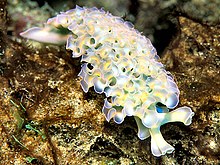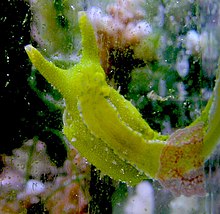Sacoglossa
| Sacoglossa Temporal range:
| |
|---|---|

| |
| Elysia crispata, a shell-less species in the family Placobranchidae | |

| |
| Oxynoe olivacea, a Mediterranean shelled sacoglossan in the family Oxynoidae | |
| Scientific classification | |
| Kingdom: | |
| Phylum: | |
| Class: | |
| (unranked): | |
| Suborders[4] | |
| |
| Diversity | |
| 284 species[5] | |
| Synonyms | |
|
Ascoglossa Bergh, 1876 | |
Sacoglossa, commonly known as the sacoglossans or the "sap-sucking sea slugs",[6] are a clade of small sea slugs and sea snails, marine gastropod mollusks that belong to the clade Heterobranchia. Sacoglossans live by ingesting the internal contents of algae, hence the adjective "sap-sucking".
Some sacoglossans simply digest the sap which they suck from the algae, but in some other species the slugs sequester and utilize within their own tissues, living chloroplasts from the algae they eat, a very unusual phenomenon known as kleptoplasty. This earns them the title of the "solar-powered sea slugs", and makes them unique among animals.[7]
Sacoglossa can be divided into shelled (Oxynoacea) families and non-shelled (Plakobranchacea) families. [8] There are however four families of shelled species: Cylindrobullidae, Volvatellidae, Oxynoidae and Juliidae. Saccoglossans are distinguished from related groups by the presence of a single row of teeth on the radula. The teeth are adapted for the suctorial feeding habits of the group.[9]
Kathe R. Jensen (2007)[5] recognized 284 valid species within the Sacoglossa.
Appearance
Many of the organisms (e.g. Elysia spp.) resemble winged slugs with a pair of cephalic tentacles. In photosynthetic members of the group, the wings, or parapodia, can be unfurled to maximise the area of the organism that is struck by sunlight.[10] Others (e.g. Placida spp.) have cylindrical cerata extending from the dorsal surface. The majority of the organisms are between one and three centimetres in length; they are typically uniform in colour by virtue of adapting ingested chloroplasts into their own cells.[1]
Distribution
The species mainly live in the central Pacific Ocean, where they frequent the shorelines of tropical islands; diverse tracts of species are also known in the Caribbean and Indomalaya. These three provinces have distinct ranges of species, indicating a high degree of biogeographic separation. Where saccoglossans are present further from the equator, in places such as Australia or Japan, diversity is lower, and the species present are typically tropical species that have a higher tolerance for temperature variation. Their temperate distribution closely maps to the distribution of their important food source Caulerpa.[5] They typically live at very low population densities, making scientific study of the group difficult.[1]
Use of ingested cellular material
The sacoglossans can utilise the chloroplasts of the algae on which they feed, which they keep alive for hours to months after their ingestion. They maintain the cells and metabolise the photosynthetic products;[4] this process is termed kleptoplasty, and the sacoglossans are the only animals to employ it; some ciliates and foramanifera (protists) also employ the strategy.[10] Sacoglossans have been known to survive for months living solely on the photosynthetic products of their acquired plastids.[10] This process is somewhat mystifying, as the upkeep of chloroplasts usually requires interaction with genes encoded in the plant cell nucleus. This almost seems to suggest that the genes have been laterally transferred from algae to the animals.[10] DNA amplification experiments on E. chloritica adults and eggs using V.litora derived primers revealed the presence of psbO, an algal nuclear gene. These results support the inter-domain horizontal transfer of an algal gene to a mollusk host, its expression in that host, and its insertion into the germline even though the plastids are not transmitted vertically in the sea slugs. [11] Sacoglossans are able to to choose which method of feeding they utilize. The switch from active feeding to photosynthesis in sacoglossans is triggered by the shortage of food resource, and typically not preferred. If food is readily available, the animal will actively consume. Starvation periods (periods of photosynthesis and no active feeding) vary between species of sacoglossans from less than a week to over four months and is used as a last resort mechanism to avoid mortality.[12]
Another unclear step in the process is how the chloroplasts are protected from digestion, and how they adapt to their new position in animal cells without the membranes that would control their environment in the algae.[10]
However it is achieved, kleptoplasty is an important strategy for many genera of Placobranchacaea. One species of Elysia feeds on a seasonally-calcifying alga. Because it is unable to penetrate the calcified cell walls, the animal can only feed for part of the year, relying on the ingested chloroplasts to survive whilst the foodstuff is calcified, until later in the season when the calcification is lost and the grazing can continue.[10]
Sacoglossans can also utilize anti-herbivory compounds produced by their algal foodstuffs to deter their own would-be predators, in a process termed kleptochemistry.[4] This may be achieved by converting algal metabolites to toxins,[13] or by using algal pigments for camouflage in a process termed nutritional homochromy.[10] [14]
Oxynoacea
Around 20% of sacoglossan species bear a shell. The Oxynoacea contains three shelled families, and all feed solely on algae of the genus Caulerpa.[1] None of these organisms benefit from the photosynthesis of the ingested chloroplasts, but there is some suggestion that the chloroplasts may have been retained in order to perform a camouflaging function.[10] The shells of the Volvatellidae and Oxynoidae somewhat resemble those of the Cephalaspid bubble snails. The Juliidae are extraordinary in that they are shelled, bivalved, gastropods. They have a shell in two pieces which resemble the valves of a minute clam. Living members of this family has been known since 1959,[citation needed] and had previously only been known to science as fossils (which had been interpreted as bivalves).[citation needed]
Placobranchoidea
No other sacoglossans bear a shell; consequently the placobranchoidea are grouped into the vernacular term "sea slugs", which can lead to their confusion with the unrelated nudibranchs. However, the placobranchoid Elysia (and undoubtedly others) does develop a shell before hatching from its egg.[15] Indeed, at least the Elysiidae, Limapontiidae and Hermaeidae all bear larval shells, which are spiral and possess between three-quarters and a single whorl.[16]
The placobranchoids have a more diverse feeding range than the Oxynoacea, feeding on a wider range of green (and sometimes red)[10] algae and even, in three cases, being carnivorous.[1]
Evolution
The ancestor of the Sacoglossa is presumed to have fed on a now-extinct calcifying green alga in the Odoteaceae.[1] The first fossil evidence of the group comes from bivalved shells dating to the Eocene, and further bivalved shells are known from later, although the thin nature of the shells and their high-erosion habitat make for poor preservation.[1] The corresponding fossil record of algae points to an origin of the group deeper in time, perhaps as early as the Jurassic or Cretaceous.[1]
The loss of a shell, apparently a single evolutionary event, opened up a new ecological avenue for the clade, as the chloroplasts of the green algae on which they fed could now be retained and utilised as functioning chloroplasts to generate energy by photosynthesis.[1]
Taxonomy
2005 taxonomy
In the taxonomy of Bouchet & Rocroi (2005),[17] the clade Sacoglossa is arranged as follows:
- Subclade Oxynoacea
- Superfamily Oxynooidea: family Oxynoidae, family Juliidae, family Volvatellidae
- Subclade Placobranchacea
- Superfamily Placobranchoidea: family Placobranchidae, family Boselliidae, family Platyhedylidae,
- Superfamily Limapontioidea: family Limapontiidae, family Caliphyllidae, family Hermaeidae
In this taxonomy the family Elysiidae Forbes & Hanley, 1851 is considered a synonym of the family Placobranchidae Gray, 1840 and the families Oleidae O'Donoghue, 1926 and Stiligeridae Iredale & O'Donoghue, 1923 synonyms of the family Limapontiidae Gray, 1847
The family Cylindrobullidae belongs to the superfamily Cylindrobulloidea in the sister "group" Cylindrobullida.[18]
2010 taxonomy
Jörger et al. (2010)[2] have moved Sacoglossa to Panpulmonata.
Molecular phylogeny analysis by Maeda et al. (2010)[19] have confirmed placement of Cylindrobulla within Sacoglossa.[19]
References
- ^ a b c d e f g h i Attention: This template ({{cite doi}}) is deprecated. To cite the publication identified by doi:10.1023/A:1018468420368, please use {{cite journal}} (if it was published in a bona fide academic journal, otherwise {{cite report}} with
|doi=10.1023/A:1018468420368instead. - ^ a b Jörger K. M., Stöger I., Kano Y., Fukuda H., Knebelsberger T. & Schrödl M. (2010). "On the origin of Acochlidia and other enigmatic euthyneuran gastropods, with implications for the systematics of Heterobranchia". BMC Evolutionary Biology 10: 323. doi:10.1186/1471-2148-10-323.
- ^ Ihering H. v. (1876). "Versuch eines natürlichen Systemes der Mollusken". Jahrbücher der Deutschen Malakozoologischen Gesellschaft 3: 97-148. Sacoglossa is on the page 146.
- ^ a b c After Attention: This template ({{cite doi}}) is deprecated. To cite the publication identified by doi:10.3989/scimar.2004.68s1227, please use {{cite journal}} (if it was published in a bona fide academic journal, otherwise {{cite report}} with
|doi=10.3989/scimar.2004.68s1227instead. - ^ a b c Jensen K. R. (November 2007). "Biogeography of the Sacoglossa (Mollusca, Opisthobranchia)". Bonner zoologische Beiträge 55(2006)(3-4): 255–281.
- ^ Anonymous. (Last changed: December 2008). "Sap-sucking slugs". Accessed 12 January 2010.
- ^ Händeler K., Grzymbowski Y. P., Krug P. J. & Wägele H. (2009) "Functional chloroplasts in metazoan cells - a unique evolutionary strategy in animal life". Frontiers in Zoology 6: 28. doi:10.1186/1742-9994-6-28.
- ^ Handeler, K.; Grzymbowski, Y. P.; Krug, P. J.; Wagele, H. (2009). "Functional chloroplasts in metazoan cells - a unique evolutionary strategy in animal life". Front Zool. 6: 28.
- ^ Barnes, Robert D. (1982). Invertebrate Zoology. Philadelphia, PA: Holt-Saunders International. p. 377. ISBN 0-03-056747-5.
- ^ a b c d e f g h i Attention: This template ({{cite doi}}) is deprecated. To cite the publication identified by doi:10.1007/978-1-4020-4061-0_23, please use {{cite journal}} (if it was published in a bona fide academic journal, otherwise {{cite report}} with
|doi=10.1007/978-1-4020-4061-0_23instead. - ^ Rumpho, M. E.; Worful, J. M.; Lee, J.; Kannan, K.; Tyler, M. S.; Bhattacharya, D.; Moustafa, A.; Manhart, J. R. (2008). "Horizontal gene transfer of the algal nuclear gene psbO to the photosynthetic sea slug Elysia chlorotica". Proc Natl Acad Sci U S A. 105 (46): 17867–71.
- ^ Middlebrooks, M. L.; Pierce, S. K.; Bell, S. S. (2011). "Foraging behavior under starvation conditions is altered via photosynthesis by the marine gastropod, Elysia clarki". PLoS One. 6 (7).
- ^ Attention: This template ({{cite doi}}) is deprecated. To cite the publication identified by doi:10.1016/0305-0491(94)90170-8, please use {{cite journal}} (if it was published in a bona fide academic journal, otherwise {{cite report}} with
|doi=10.1016/0305-0491(94)90170-8instead. - ^ Clark, K. B.; Jensen, K. R.; Stirts, H. M. (2009). "Survey for Functional Kleptoplasty among West Atlantic Ascoglossa (= Sacoglossa) (Mollusca, Opisthobranchia)". Veliger. 33 (4): 339–345.
{{cite journal}}: Cite has empty unknown parameter:|1=(help) - ^ Thompson, T. E.; Salghetti-Drioli, U. (1984). "Unusual features of the development of the sacoglossan Elysia hopei in the Mediterranean Sea". J. Mollus. Stud. 50 (1): 61–63.
- ^ THOMPSON, T. E. (1961). "THE IMPORTANCE OF THE LARVAL SHELL IN THE CLASSIFICATION OF THE SACOGLOSSA AND THE ACOELA (GASTROPODA OPISTHOBRANCHIA)". J. Mollus. Stud. 34 (5): 233–238.
- ^ Bouchet, P. & Rocroi, J.-P. (2005). "Classification and Nomenclator of Gastropod Families". Malacologia. 47 (1–2): 1–397.
{{cite journal}}: CS1 maint: multiple names: authors list (link) - ^ Discussion in the Seaslug Forum : Ascobulla, Cylindrobulla.
- ^ a b Maeda T., Kajita T., Maruyama T. & Hirano Y. (2010). "Molecular Phylogeny of the Sacoglossa, With a Discussion of Gain and Loss of Kleptoplasty in the Evolution of the Group". Biological Bulletin 219(1): 17-26. abstract.
Further reading
- Marcus E. d. B.-R. (1982). "Systematics of the genera of the order Ascoglossa (Gastropoda)". Journal of Molluscan Studies. 48 (supp10): 1–31.
